His striking yellow feathers belied his otherwise unassuming stature. He was not much bigger than a canister of film and alighted in my favorite tree, a crabapple. Magenta buds that were about to pop into blush-pink blossoms covered the limb where he perched.
I’d been studying the tree, absent-mindedly, for the better part of a month. I never used to have a favorite tree. I didn’t pay attention to birds. But I’ve done a lot of looking out of my window the past two years. Maybe you have, too.
I spotted the American goldfinch a few more times while stay-at-home orders were in place where I live in the spring of 2020. As the pandemic changed the world around us, I looked forward to the days when I might spy that bright-yellow flicker beyond my windowpane.
Soon, I researched other birds that came to a pit stop in my crabapple tree. There were house finches and swallows and various buntings—the Lazuli was a quick favorite. I bought a reference book, then another, and downloaded an app. By August, I’d purchased a basic pair of binoculars so I could study the red-shouldered hawks that circled on thermals before landing on my fence.
Although I couldn’t hike, camp, ski or climb mountains like I’d planned, I found solace in my backyard. Other REI Co-op Members did, too. In the stories that follow, they share essays about close-to-home discoveries and a new appreciation for the outdoors. They dish their tips and tricks for redefining and reimagining what a life outside can be. After all, sometimes that just means looking outside your window.
—Maren Horjus, Editor
Jump Ahead for More Stories
- Marooned with Long Covid: At 29, I have had to adapt from a life of movement in nature to one centering stillness and observation.
- Becoming a “Real Hiker“: I started hiking more than a year ago when the pandemic relegated me to my 800-square-foot apartment and whatever outdoor space I could find close to home.
- Roller-Skating with the ‘Memphis Skater Hotties’: Outdoor skating is ‘freeing’ for me; it challenges my agility, body and capabilities…
- A Fitness Glow-Up Inspired Adele : No amount of social media scrolling or Netflix streaming could alleviate the collective anxiety in the house after so many days inside. I had to find a way to be on for my family, but also take care of myself.
- Reshaping What It Means to Be a Runner: Over time, running became less and less about achieving a physical goal—weight loss, a certain physique—and more about feeling good mentally.
- Ski Touring Adventures Near and Far: Through touring, I was able to ski more frequently, explore new places—often closer to home—and open myself up to different kinds of adventures.
- Overlanding for Solitude, Self-Reliance and Stars: Everything I need—including a bed, food, water and even a bathroom—is inside or attached to my Jeep.
- A Beginner Discovers the Rhythms of Climbing: For a few hours, we’d trade the year’s amorphous problems for smaller ones we could redpoint, encouraged by the progress of each new send.
- The Face Mask Joins the Pack List: Whenever I load up my pack for an outdoor adventure, I include a face mask in my Ten Essentials list, slotted under extra clothing or first-aid supplies.
Marooned with Long Covid
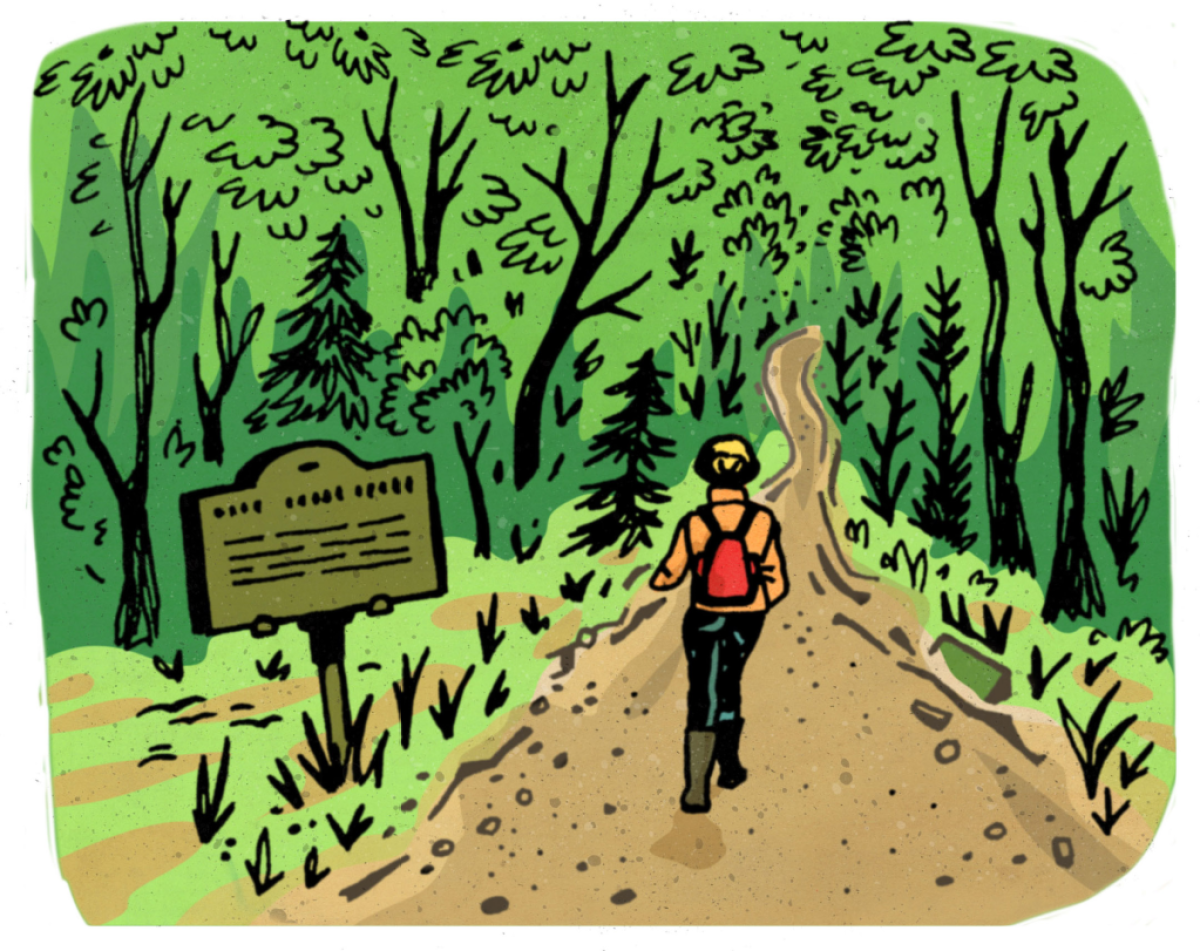
The gentle trail led me through an expansive landscape to a bluff overlooking thousands of pinnipeds. Elephant seals, California sea lions, Guadalupe fur seals bathed in the sun that had just burnt off the morning’s thin tablecloth of clouds. The animals groaned, yelped and grunted as the thick smell of their colonies mingled with the stench of drying bullwhip kelp.
I spent the morning with the pinnipeds, hunkered near the cliff’s edge with a pair of binoculars on San Miguel Island, part of Channel Islands National Park off the coast of California. It was my first solo adventure since becoming disabled with long Covid in 2020; like one of the millions of people, I experience long-term effects from the illness. My exploits as a thru-hiker, mountaineer and climber have been winnowed to accommodate my intolerance of physical and intense cognitive activity, which worsens my core symptoms of sailboat-in-storm nausea, disorienting cognitive dysfunction and 20,000-leagues-under-the-sea fatigue.
At 29, I have had to adapt from a life of movement in nature to one centering stillness and observation. Watching birds in my backyard and—if I stay within my energy threshold—a trip to watch sea mammals frolic in coves are what I can manage now.
The daily challenges of the illness have upended my ability to work full-time and enjoy my favorite hobbies, and my symptoms have not improved much over the past two years. I’ve traded backcountry pack-in sites for car camping, staying strictly within my envelope to ensure I didn’t exacerbate the post-exertional malaise. PEM is common in patients with myalgic encephalitis/chronic fatigue syndrome (ME/CFS), a symptom also common in long Covid patients. Even minor activity can make us bedbound for days or weeks. One ME/CFS patient explained in my online support group that it is like stepping in quicksand—the more you do, the more you sink.
But by the fall of 2021, I finally felt confident in my ability to handle a more merciful adventure within my energy parameters. I was determined to escape from the realities of my condition, to remember the sense of calm that wilderness has always brought me. I embarked on a long ferry ride to San Miguel Island.
The rugged, steep landscape and unpaved trails make San Miguel, like many locations on our public lands, inaccessible to many people with physical disabilities. I was keenly aware of that while hiking the steep trail up Nidever Canyon to the island’s small, moss-covered pack-in campsite, breaking my gear and water stash into manageable loads that I portaged in a few trips. At one time I hiked 25 miles a day with a full pack; now, I struggle trekking less than a mile with a third of my pack weight.
Within my online long Covid support group are former ultramarathon runners who can no longer make the distance to their own mailboxes since contracting COVID-19. Microclots have been found in the blood of many Long Covid patients, as well as evidence of serious cognitive issues. Disability advocates have been warning us that mass infection of Covid would lead to a mass disabling event. Current figures show they were correct, and we will not get better unless our illness is taken seriously with fast-track research and clinical trials.
While isolating myself on the island for four days, I spent many hours thinking, reading and writing from my campsite, nestled next to dormant flowers of giant coreopsis. The trip, unlike group car camping outings I had done before, was entirely my own to plan and enjoy. I rested when I needed to and woke up from naps to the sound of song sparrows. Cut off from the world, I was able to rest for the first time since falling ill.
I turned over the word “marooned” in my head as I breathed in the cold Pacific air. In the past, I thought of it as a word that only concerned, well, pirates. But becoming chronically ill has shown me that you can be marooned not only on an island but from your past self, from an entire ableist society. The challenges of my trip are just one representation of how I’ve had to learn how to readjust my daily life. So many things that I once did without a second thought—getting on my feet in the morning, writing an email, a long drive—have become obstacles I have to pace to endure. Only after developing long Covid did I realize how overlooked people with disabilities are in our society and how much privilege I’d had when I was able-bodied.
But it shouldn’t be only on individuals to adjust to those changes. For decades, those with ME/CFS have been treated with skepticism or ignored by physicians and others. As millions of long Covid patients relearn our relationship with our new bodies and realities, I hope our society can find the strength to confront our discomfort with disability and send lifeboats to those in need.
—Miles W. Griffis, REI Co-op Member since 2012
Becoming a “Real Hiker”
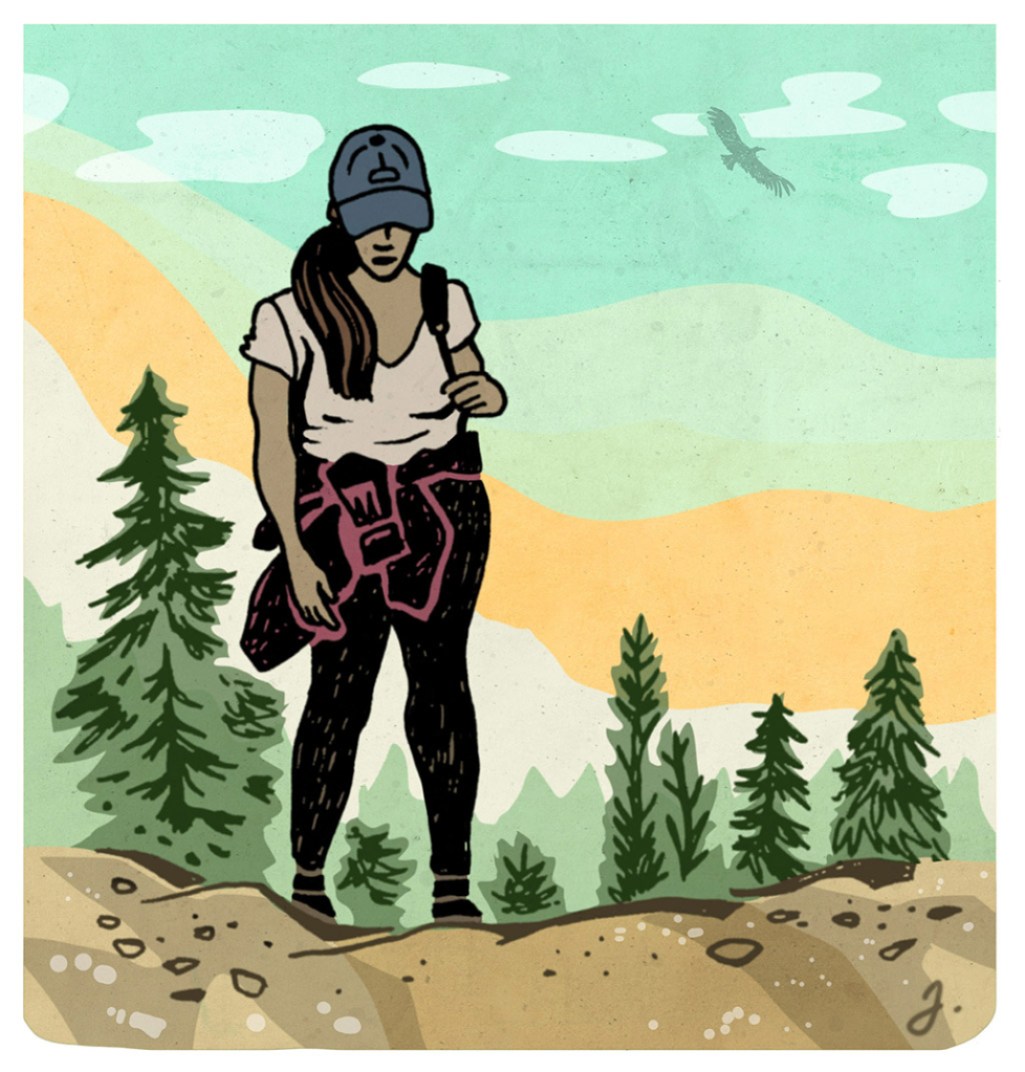
“Do you know how much farther it is?”
“About half a mile,” I cheerily reply as I scramble up a red-rock ramp near where the man wipes his brow in the shade of a ponderosa pine. “You’re so close!” I add. It’s the first time anyone has asked me for trail advice on a hike.
It’s late summer in 2021. When my schedule allows for it, I like to climb Mount Sanitas, a rocky, scrubby 6,863-foot summit close to where I live in Boulder, Colorado, on Friday mornings. It shares the pinkish rock of the Flatirons and has so many excellent views that it famously has four false summits. If I leave my place by 6am, I can be off the trail—a 3-mile loop—and showered in time for my nannying gig at 9am.
I’m probably not what you think of when you read that. I’m not an ultrarunner, yoga instructor or “real hiker” like so many other Boulderites. Before, I thought of a real hiker as someone who calls themselves a hiker. They probably wear boots and a backpack and cargo pants. They know how to read a map! They go fast and far and “talk the talk.” I just like to be outside, so I never thought of myself as a hiker. I haven’t set any FKTs and, in fact, only learned what that acronym meant in this interview (it stands for “fastest known time,” and if anything, my reputation is for moving slowly and taking many snack breaks).
But, in my opinion, that’s perhaps the best thing about hiking. There are no real right or wrong ways to do it.
I started hiking more than a year ago when the pandemic relegated me to my 800-square-foot apartment and whatever outdoor space I could find close to home. A friend invited me to climb Sanitas with her a few times, and after learning where to park and how to navigate the route without referencing my phone, I felt confident I could do it on my own. It wasn’t easy (locals call one half of the loop “The StairMaster”), and I was continuously passed by other hikers.
But no matter how many times I stopped or how many people buzzed past me, I always felt great when I reached the top and even better when I returned to my car. I was proud of myself, and I loved the feeling of moving my body and breathing fresh air.
Eventually, I began exploring other trails nearby, and before I knew it, I’d developed a pattern: I’d go for a hike once a week, if time allowed. If it didn’t, I’d make a concerted effort to clock at least a little outdoor time, whether it was circling my neighborhood on foot or walking to my local grocery store.
Mount Sanitas is still my favorite, though, so I’m pleased to see a person who seems to be a first-timer on this Friday hike. As I continue up the peak’s south flank, I think about him. I hope he keeps going; the bird’s-eye view over Boulder from the top is arresting. You can peer south across the jagged Flatirons or north toward Rocky Mountain National Park and the bald peaks of Arapaho, Cheyenne and Ute lands. Or you can look east, clear across Boulder to where the horizon melts into Kansas.
I’m sure he’ll love it—any real hiker would.
–Margaret Costley, as told to Maren Horjus
Gear Up Like Maggie
For any basic hiking—let’s say walking on unpaved terrain—you don’t need much.
Salomon Speedcross 5 Trail-Running Shoes
For the first few months of my hiking routine, I got away with wearing old running shoes. But the nearby trails are hilly and dusty, and I wanted more traction. The Speedcross 5 has a sticky outsole that’s dotted with lugs that claw into the trail like a cleat. It’s more breathable than a leather hiking boot, but still durable. I also like the single-pull laces. $130
I’ve also upgraded my outer layer. The Factor hoodie takes the bite out of the morning chill on my early hikes. It’s fleecy next to my skin and wears like my favorite cotton sweatshirt, but the fabric is breathable and quick-drying. It has two zippered hand pockets and a chest pocket. $145
For the sort of hiking I do, I don’t need a huge pack. Instead, I like this 5-liter waistpack, which easily holds my water, keys, money, phone, lip balm, first-aid supplies and, you guessed it, snacks. I can even stuff a layer inside if I’m feeling ambitious. $49.95
Roller-Skating with the ‘Memphis Skater Hotties’
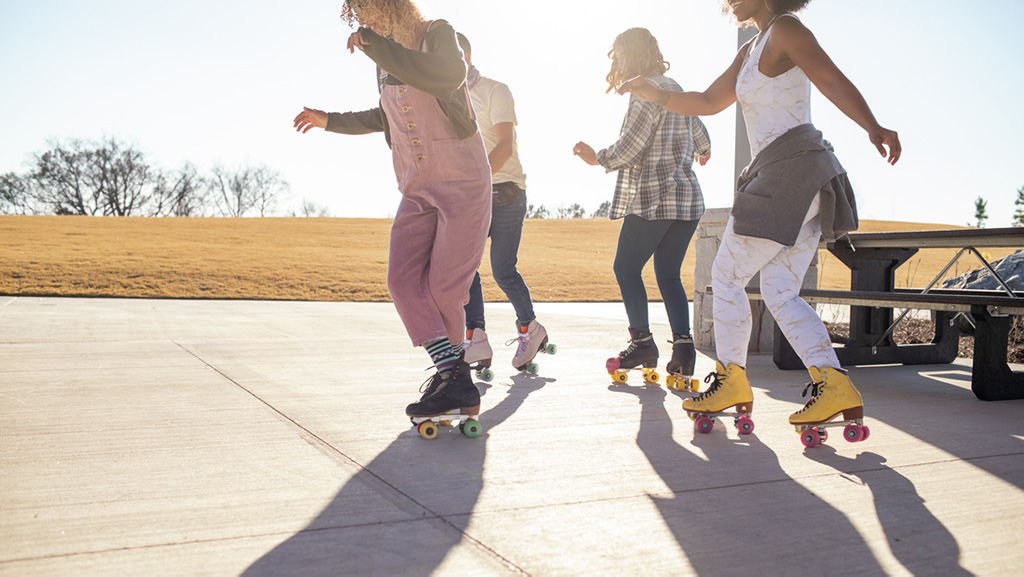
“During the height of the pandemic, I sought out ways to bring myself joy. Whether it was art, science, food or skating, I tapped into all of my interests as a means of self-care. Outdoor skating is ‘freeing’ for me; it challenges my agility, body and capabilities as a 30-plus-year-old skater. I’d always been active as a child (ice skating, band, tennis), but I took up roller-skating [two] years ago. See, roller-skating has always held significance in the African American community.
After sharing my love of skating with friends on Instagram, more women reached out to join me. We call ourselves the ‘Memphis Skater Hotties.’ We’re a diverse group of women of all ethnicities, sizes and skill levels who enjoy skating and love the outdoors. We are a community that comes together weekly to improve our physical, emotional, mental and environmental wellness. It’s far from simply skating; it’s family, fitness and so much fun!”
—Ali Manning
A Fitness Glow-Up Inspired by Adele
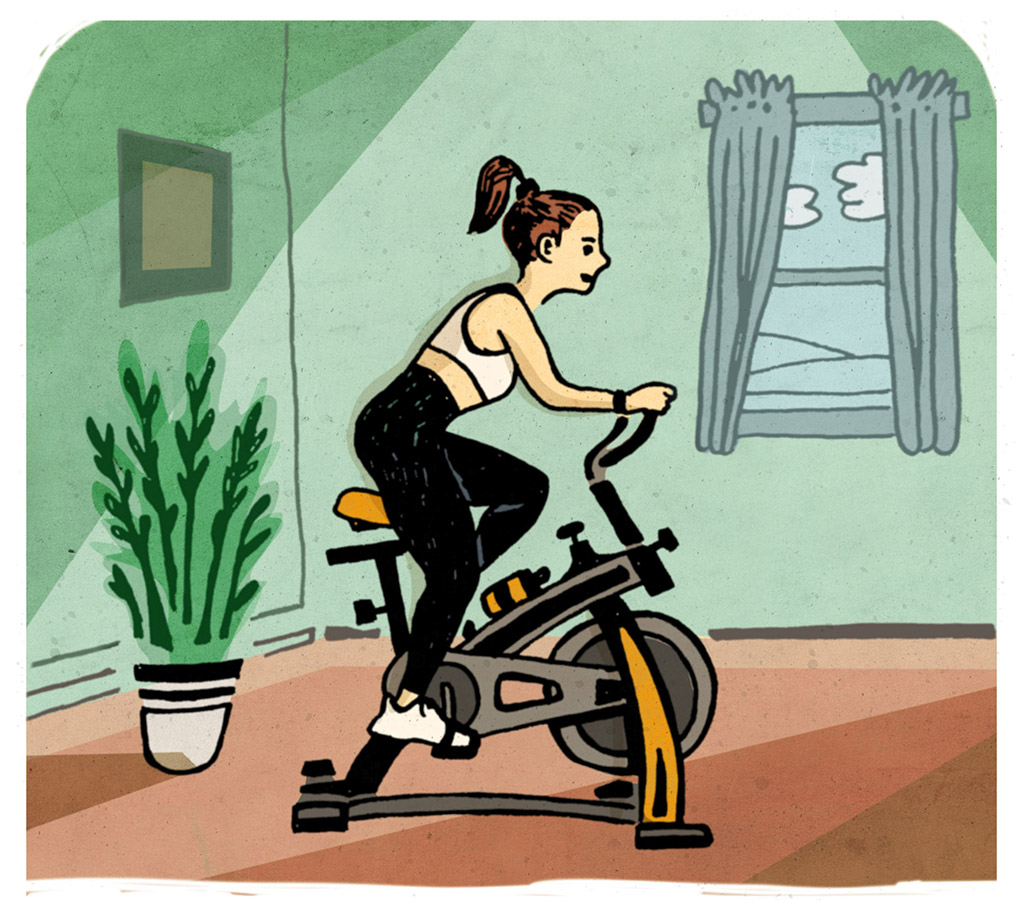
My first memory of fitness was finishing last—chest heaving, heart sputtering—in the 600-meter race in fourth grade. Remember those presidential fitness tests that measured your speed, endurance and flexibility? It included feats like the flex-arm hang, which I could do for about a millisecond. Later, in high school, I remember running up to the pommel horse and slamming it so hard that it lifted off the base before falling right down on my toes. I howled in pain. People laughed. I’m still not over it.
So when, as an adult, friends or colleagues spoke of the euphoric effects of exercise, such as the runner’s high, I scratched my head. Endorphins? What the heck are those?
After marriage and three babies, I still hadn’t operationalized a fitness regimen. I took care of everyone else but myself. When my pants got tighter, I just bought more leggings and A-line dresses with loud prints. My body wasn’t really my own. It was a tool to do things for other people.
And then COVID struck in 2020. My once-deserted home office, which had spanned three floors of my house, became the virtual classroom for three kids: my nonverbal, autistic 5-year-old son; my 15-year-old, a vocalist at a Chicago performing arts school who was required to practice arias for three hours a day; and my angsty 16-year-old juggling the intense college application process. No amount of social media scrolling or Netflix streaming could alleviate the collective anxiety in the house after so many days inside. I had to find a way to be on for my family, but also take care of myself.
So, I got a bike.
The indoor bike trainer arrived on a slushy Chicago morning. We set it up in our basement, and I posted about it on social media—not to humblebrag, but to hold myself accountable. My caption: “Look out for an Adele-style comeback in summer 2021.” This is how it would be done, I promised myself. I’d hit the bike for at least 20 minutes a day, twice a day if possible, and the pounds would melt away.
What surprised me more, though, is how my anxiety did as well. I reconnected with my breath. I could feel my leg muscles, my back, my core. The same core—now marked with a cesarean section scar and a bit fluffy from years of being fed by a chef husband—was tightening from the inside out. I felt lighter, unencumbered and, dare I say, freer. And I could mix it up: interval training here, an advanced beginner session the next day if my backside felt sore, a yoga routine for meditation and stretching. Unlike those 50-yard dashes of the past, I didn’t have to compete against anyone but myself. In fact, I had a whole roster of people cheering me on—those virtual riding instructors and others in the online community making me believe: You got this. I’d heard that voice in other areas of my life, just not related to the one that mattered most: my health.
When the city of Chicago reopened gyms—with mask mandates—months into the pandemic, I stumbled across a hot yoga studio that lured me in with its R&B and hip-hop playlist, its darkened room and its sauna-like warmth. Sometimes I get so in my head—between the kids, my job, the to-do lists—that I need something of hot yoga-level intensity to dissipate the tension in my bones. Combined with the indoor bike trainer, better sleep and a diet built on moderation with room for cheating, this became a strategy that worked for me. And it still does.
I love the mind-body connection of it all—the communal aspect of a class sweat, the lifting, the elongating, the bending, the pushing through hard moments of sweat and tears. After visiting my first yoga class, I ran into a guy coming out of the studio who said, “It’s like being born again.”
It is. Every time.
—Valerie Moloney, REI Co-op Member since 2022
Reshaping What It Means to Be a Runner
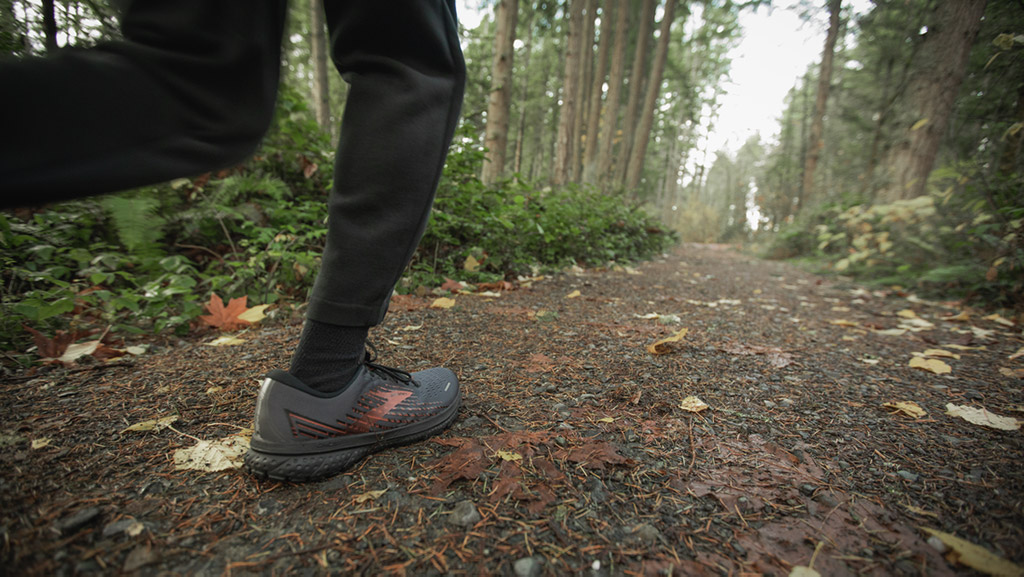
Three years ago, Chelsea Davis didn’t identify as a runner. Sure, she’d completed a handful of half marathons over the years and laced up her running shoes with some regularity. But she didn’t consistently train. And when she considered what it meant to be a runner, she envisioned someone who ran faster and more competitively than she did. She didn’t feel she’d earned the title.
That changed in early 2019 and then again in 2020 when she leaned into her hobby to cope with the loss of a friend and a budding global pandemic. Slowly, she began to reshape her definition of a runner.
In May 2019, Davis lost a close friend to suicide just before she was set to run a half marathon in Mazama, Washington. Grieving, she debated pulling out of the race. Instead, she decided to run it in his honor, and she soon discovered that it also helped her process her immense grief. “That was kind of my starting point of really running for a purpose, for mental health. I would say it was for him but also for myself,” she said.
Nearly a year later, as the pandemic upended people’s lives, she again turned to running for comfort. During stay-at-home orders, it was one of the few close-to-home activities she could enjoy while social distancing. It provided a way to get outside, move her body and relax her mind.
“That connection of mental health to exercise. I always kind of knew that was a thing, but I don’t think I realized how much I needed that until I pushed myself to get out there,” she said.
Over time, running became less and less about achieving a physical goal—weight loss, a certain physique—and more about feeling good mentally. And as her purpose evolved, so did her definition of what it meant to be a runner.
“I used to solely think of running as a way to get skinnier. A way to run off big meals. A way to convince my tall, strong frame to shrink,” she said. “I think the shift happened because during the pandemic I stopped caring so much about if I was skinny, attractive, etc., and ran because it was one of the only things that calmed the brain chaos.”
And Davis has continued to run, knowing the sport is as much a tool to strengthen her body as it is a salve for weathering hard times.
Chelsea’s Tips for New Runners
New to running? Not to worry. Davis has tips for those just starting.
- Find a running buddy. Chelsea’s typical running partners: her stepmom and her 4.5-year-old mutt, Albus.
- Go at your own pace. It’s not about running fast, especially in the beginning. “Be super patient,” she says.
- Set a goal. This one can vary greatly from person to person, but Chelsea loves having a race to train for and typically runs one every couple of months.
- Use a training plan. Hal Higdon’s free app, Run With Hal, helps Chelsea stay on track. But there are plenty of free plans and programs, like this 5k training plan.
- Start with a stretch. Chelsea begins every run with dynamic stretching. “I didn’t start that until recently, and now it’s a necessary part of my routine,” she says.
—Chelsea Davis, REI Co-op Member since 2006
Gear Up Like Chelsea
The great thing about running: You don’t need much beyond a solid pair of shoes to get started. Over time, you can invest in items like a smartwatch to track your mileage. Here are my favorites:
I’ve tried many running shoes, and the only ones for me are Brooks. They keep my knees feeling good and are comfortable even on the 12-plus mile runs. A perfect amount of cushion and enough room in the toes to avoid bruising. Starting at $130
Janji 7/8 Groundwork Tights 2.0
I am curvy, so I’ve always had the issue of pants not staying up, and Janji are some of the only pants without that problem, especially on long runs. Starting at $88
I love the accuracy of the watch! All the fun stats you get about your run and whether you’re training enough is super helpful in keeping me on track. It’s also good encouragement to run more hills and try and improve my time (eventually). $249.99
Albus is my favorite running buddy, and a leash is awesome because it allows me to be hands-free. I can carry my keys and phone in the little belt pocket, and it has a water bottle holder for longer runs. There’s also a quick-release feature so he can’t pull me to the ground. $69.95
Ski Touring Adventures Near and Far
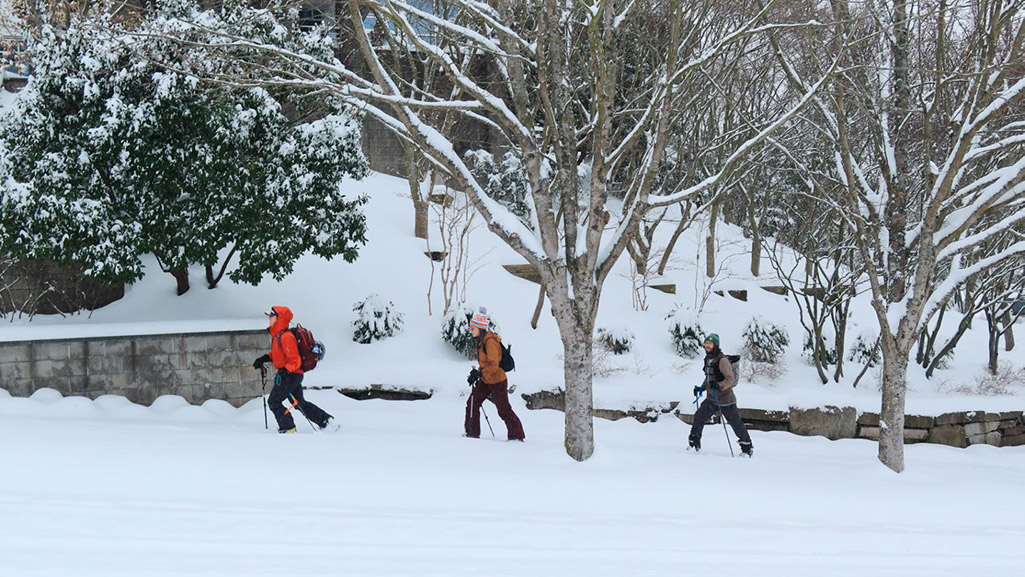
I peered over the edge of the snow-covered slope. “Do you think we can ski it?” my friend asked. Our group evaluated the obstacles along the descent: small rocks, brush, concrete. It was worth a shot, we agreed. The route? A quick drop off Ward Street. We weren’t miles into the backcountry or staring down a gnarly double black diamond at a ski resort. We were less than a mile from home—near the top of Queen Anne, a neighborhood in Seattle (elevation: 257 feet).
Every few years, Seattle gets enough snow that enthusiastic skiers, snowboarders and sledders flood the streets. It was a Saturday morning in February 2021, a year into the pandemic, and we were hungry for any time outside. One by one, we dropped in. We let out whoops and hollers as we got in a few turns before coming to a hockey stop at the street below. Sure, we may have slightly scraped up our skis. But that was nothing compared to the childlike snow day joy we felt and the brief release from pandemic anxieties.
Skiing—even in my neighborhood—had become my salve that winter. Beyond the elusive Queen Anne Traverse, there were the weeknights I headed to The Summit at Snoqualmie, a local hill with night skiing. Even when I was exhausted from work and the weight of the pandemic, I reminded myself that it was worth the scramble to gather my gear and make the hour-long drive for the promise of fresh air and sliding on snow. It brought a welcome variety to my week and the opportunity to catch up with a small crew of friends (and see another human who wasn’t my husband).
Most often, my husband and I spent the weekends backcountry skiing—using special bindings and equipment to travel uphill and ski down outside a resort setting. It was something I found daunting prior to that season. I was often stressed by unfamiliar terrain, difficult skiing conditions and looming anxiety about avalanches, no matter the forecast. But last year, something clicked. Through touring, I was able to ski more frequently, explore new places—often closer to home—and open myself up to different kinds of adventures. I built skills and confidence with each trip. I learned to relax a bit and to enjoy the time I was able to spend outside.
My winter activity of choice during the pandemic has been skiing—something that comes with a considerable cost and acknowledged privilege. Still, what I valued most about that time wasn’t fresh powder or epic views. It was the small moments in between: Hanging out in the parking lot after a tour and sharing a pumpkin pie that I’d baked; holding my friends’ 7-month-old son and sticking our tongues out at each other while his parents got in a few laps; taking a snack break to eat Scandinavian Swimmers and bask in the glorious sunshine after relentless stretches of grey.
I skied more that season than ever before and perhaps I ever will in a single stretch again. And during those seven months, that Saturday in February was still one of my best ski days.
—Michelle Flandreau, managing editor, REI Co-op Member since 2013
Michelle’s Tips on How to Get Started Backcountry Skiing
If you’re interested in learning more about backcountry skiing or other snowsports, Expert Advice can help you hone your skills or figure out what gear is right for you. Here are a few things that helped me as I was starting to backcountry ski.
- Get safety gear. Prioritize investing in essential avalanche safety equipment (beacon, shovel and probe).
- Consider buying used gear for your first full touring setup. This can help reduce costs as you’re building out your kit and give you a better understanding of what type of skis, bindings, boots and skins you might want to purchase later.
- There’s a lot to learn, so take your time. My first season, I took a Level 1 avalanche course with snowshoes instead of backcountry skis, which allowed me to focus on avalanche rescue basics. The next season, I took an intro to touring class to work on uphill travel techniques. Splitting them up made the information more manageable.
- Practice your downhill skiing in-bounds. Before I started touring, repetition at my local ski area helped me increase my comfort in navigating challenging terrain. This allowed me to feel more prepared for conditions that can run the gamut in the backcountry.
Overlanding for Solitude, Self-Reliance and Stars
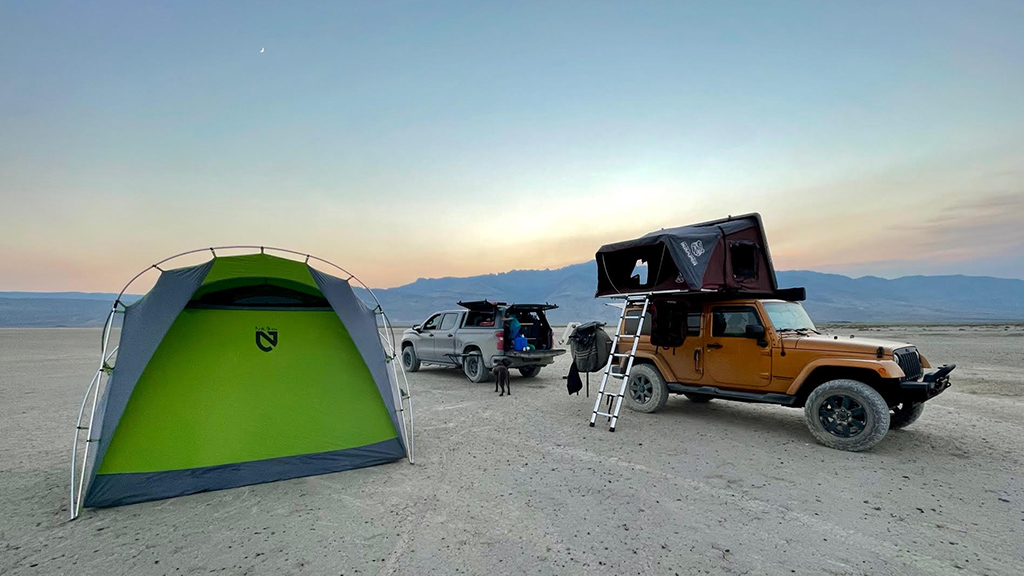
I have always preferred solitude outdoors, but the pandemic intensified my desire to go where others aren’t. Overlanding has allowed me to temporarily escape the uncertainties of the pandemic by filling my field of vision with nature alongside people in my bubble. Exploring remote places in a self-reliant way also brought me an immense sense of freedom. Everything I need—including a bed, food, water and even a bathroom—is inside or attached to my Jeep.
Last summer, I embarked on a week-long road trip through southeastern Oregon, not far from my home in Portland. The vast, open space amazed me. En route to the Alvord Desert, one of the largest dry lake beds in the state, desolate stretches of road seemed never-ending. Something about the bigness of those open spaces simultaneously made me feel small and energized. I set up my camp on the cracked desert floor. I could see in all directions for miles with no other people in sight. I marveled at the expansive nighttime sky and the intensity of the stars. The experience filled me with gratitude that these public places still exist for us to enjoy.
—Dawn Farrell, REI Co-op Member since 1993
Gear Up Like Dawn
I assembled my overlanding kit over several years, first using car-camping gear and then slowly adding bigger-ticket items like a roof-top tent and an electric cooler. Items that save storage space and pack away tidily are top of my list.
SOL Flat Pack Collapsible Sink – 16 L
Just because you’re camping doesn’t mean you can skip dish duty. I have two of these sinks—one for washing and one for rinsing. They collapse for easy storage and double as containers. $19.95
Tailgater Tire Table Original Tire Table
This is one of my go-to items. It’s a sturdy table for two people, and it folds down flat for packability. $139.95
MPowerd Luci Solar String Lights
Add instant ambiance to any outdoor setting with these portable string lights. Better still, you can use the sun’s rays to charge them on long trips. We love hanging them from the awning of our shade shelter or from trees. $49.95
Ignik Firecan Portable Fire Pit
This compact fire pit kicks out a surprising amount of heat for its size—slightly bigger than a shoebox. Pair the fire pit with the Ignik Gas Growler Deluxe, a refillable propane bottle that connects to stoves, grills and heaters, to reduce waste from single-use bottles. $199.95
I’ve thankfully never had to activate the SOS feature to contact search and rescue. But this palm-sized satellite communicator gives me peace of mind in case of an emergency. (Note: A subscription plan is required to send and receive satellite messages on this device.) $400
Dometic CFX3 55IM Powered Cooler + Icemaker
An electric cooler was a late addition to my kit because of the price. The VMSO3 compressor refrigerates or freezes to -7°F, and it produces ice. It’s nice to roam far and not worry about how long your food will last. $1,200
A Beginner Discovers the Rhythms of Climbing

I reached the top just as the clock struck midnight. Stars smeared the black sky above me, bats fluttered like tiny shadows near my head, wolves crooned from way too close. Below, my climbing partners yelled happy birthday. I’d just turned 30.
It was October 2020, and I was on a three-day rock climbing mission in eastern Washington’s desert. The pandemic brought me there. I picked up climbing five months into lockdown when a colleague said she knew someone who could teach me. I ordered the gear and placed my trust in her friend, a Mississippi native with a decade of climbing under his harness. Any apprehension I had about learning the sport—my fear of heights, my lack of know-how—dissolved into daydreams of adventure. With something novel to look forward to, I realized how eager I was to replace my pandemic hobby of doomscrolling.
I long imagined I’d begin climbing at an indoor gym with obvious handholds and plush floors. But going to a gym wasn’t an option when I started—my climbing partner and I didn’t like our odds of catching or spreading the virus. Instead, we retreated to a local crag 30 miles east of Seattle. With no climbing experience, I didn’t feel particularly averse to the idea of climbing outside. But my nerves caught up with me on those initial routes, leaving me frozen halfway up one particular ascent and audibly cursing many others. Still, just as often, I lost myself in the rhythm of the movement, the texture of the rock, the cool breeze at the top. The outings became a fresh routine, a necessary shakeup to days spent indoors.
We relished these weekly trips, practically skipping along the trails to the slabs of volcanic rock, rhythmically flaking our rope with smiles stretched across our faces. For a few hours, we’d trade the year’s amorphous problems for smaller ones we could redpoint, encouraged by the progress of each new send. Most days, we climbed until the sun melted into a candy-colored sunset, sometimes spending that final hour sitting in the dirt in silence, watching the dancer-like toe work of a stranger.
Many climbers describe this sport as meditative. In my limited experience, I’ve found there’s truth to this. There are ways to numb the pain of a hard year, but climbing demands the opposite. It invigorated my dormant muscles, focused my mind and quieted my anxieties. It provided a fresh backdrop for a 30th birthday during a year when there was little to celebrate. The problems of the pandemic persisted, but time on the rock served as a tool to process them. Even when health mandates relaxed and vaccines became an option, I stuck to climbing outside. They continue to offer a dependable peace.
On my pandemic birthday, I rested at the crux of my climb and drank in the inky sky. Later, my crew and I unfurled our sleeping bags onto the dusty desert floor and fell into a dreamless sleep in the wide embrace of eastern Washington’s rocky amphitheater. The next day—and on so many days after that—we did it all again.
—Sarah Grothjan, REI Co-op Member since 2019
The Face Mask Joins the Pack List
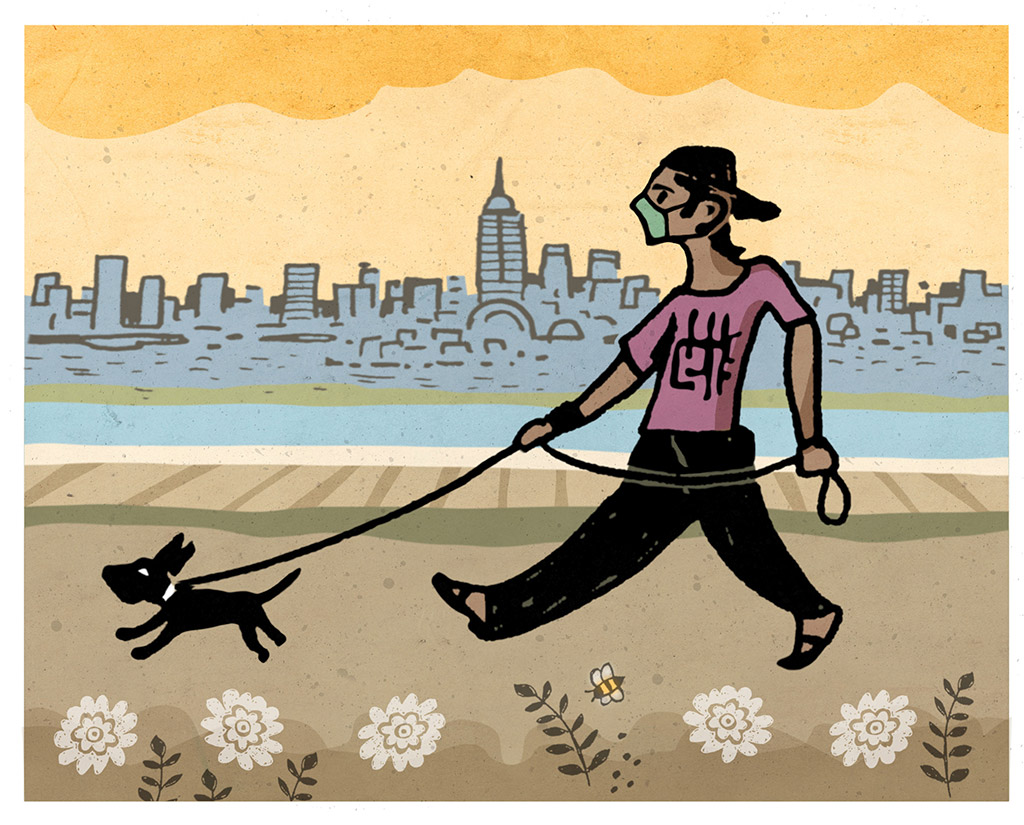
Two years into pandemic times, a humble swath of fabric has become my security blanket. I always grab it before heading out the door and have spares stashed in my car and clothing pockets. Even with mask mandates dropped in many places, I’ve become attached to the routine: baring my mouth and nose will feel like I’m in a state of undress.
Feeling as desperate as the rest of humanity, I grasped onto the face mask in the early months of the pandemic. Even a fig leaf, I figured, was better than nothing. I read post after post about mask efficacy and engineering. (Multiple layers are better and proper fit is key.) In the end, I opted for the Outdoor Research Essentials Face Mask as my primary choice, though I use others as well. I have a quickly deployable mask with a Velcro® rear closure, for example, for curbside pickups at stores or restaurants.
Whenever I load up my pack for an outdoor adventure, I include a face mask in my Ten Essentials list, slotted under extra clothing or first-aid supplies. Wearing one isn’t essential for dispersed outside activities, but I still consider it epidemiologically prudent to wear where crowds coalesce, during pit stops and when brew provisioning requires an indoors detour.
Calling my mask “dear” is only true in the same way that I revere water treatment. Warm fuzziness arises only because they both fend off viral and bacteriological ne’er-do-wells. I don’t have an exclusive relationship with my mask and have been serially unfaithful. All I require of a mask is adjustable ear loops and a pronounced nasal contour.
Ear loops present challenges, too. I sneak peeks at mirrors to be sure my ears aren’t sticking out awkwardly. A lot of other gear goes over one’s ears, too: sunglasses, beanies and more. Hearing aids, which the audiologically unimpaired can blissfully ignore, are impossible not to snare when removing ear loops. Earring wearers likely suffer a similar fate.
Foggy glasses is another masking problem many of us share. One can mitigate, but no perfect solution has emerged. A proper mask fit helps, as does lens defogger. My latest tactic, a pricey one, is contact lenses. But the need for UV protection means I often wear my prescription sunglasses outdoors, so the contacts are relegated primarily to indoor activities like grocery shopping.
Mask trial and error aside, these many months have revealed what I truly hold dear. After so many have suffered, an enduring lesson of the pandemic is that health should be cherished in good times and nurtured at all times. To that end, I recommend one of my truly favorite health-preserving practices: spending time outdoors.
—Ken Knapp, REI Co-op Member since 1977
